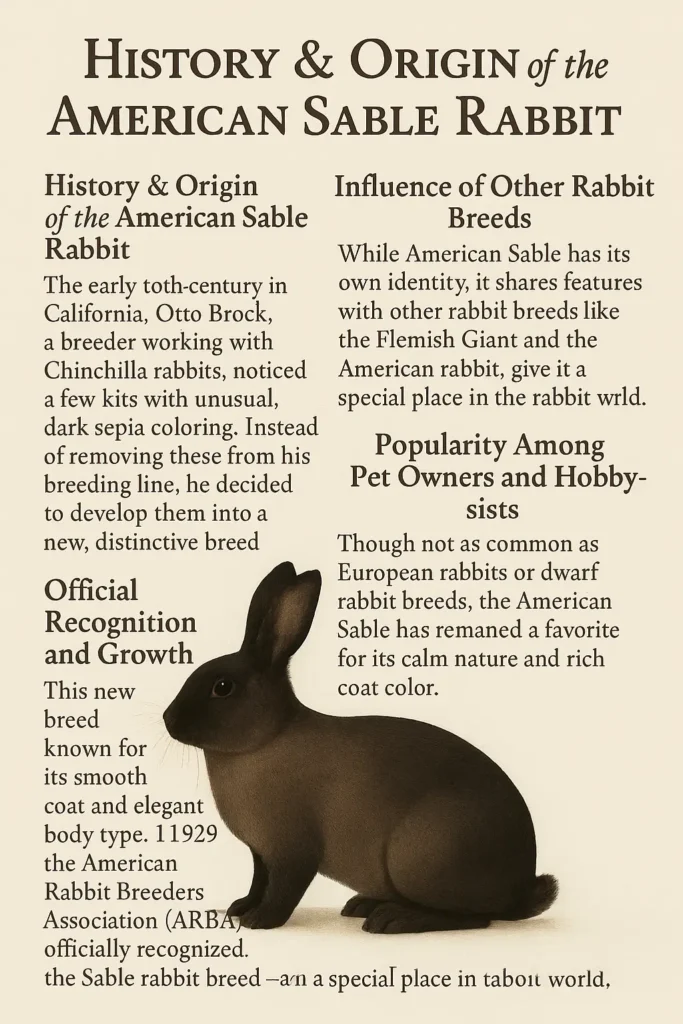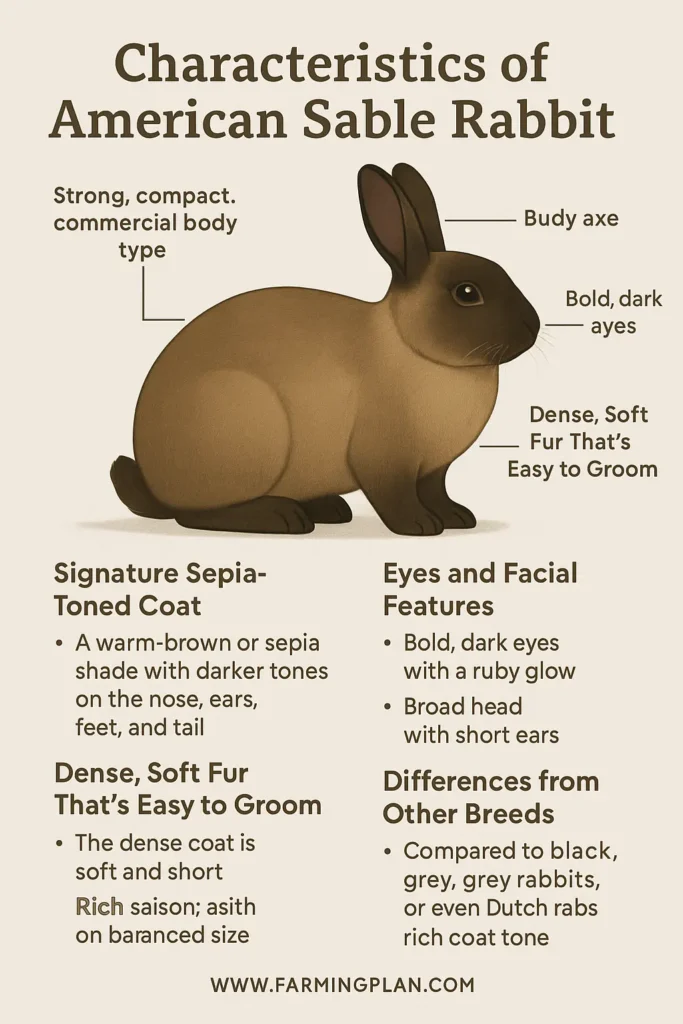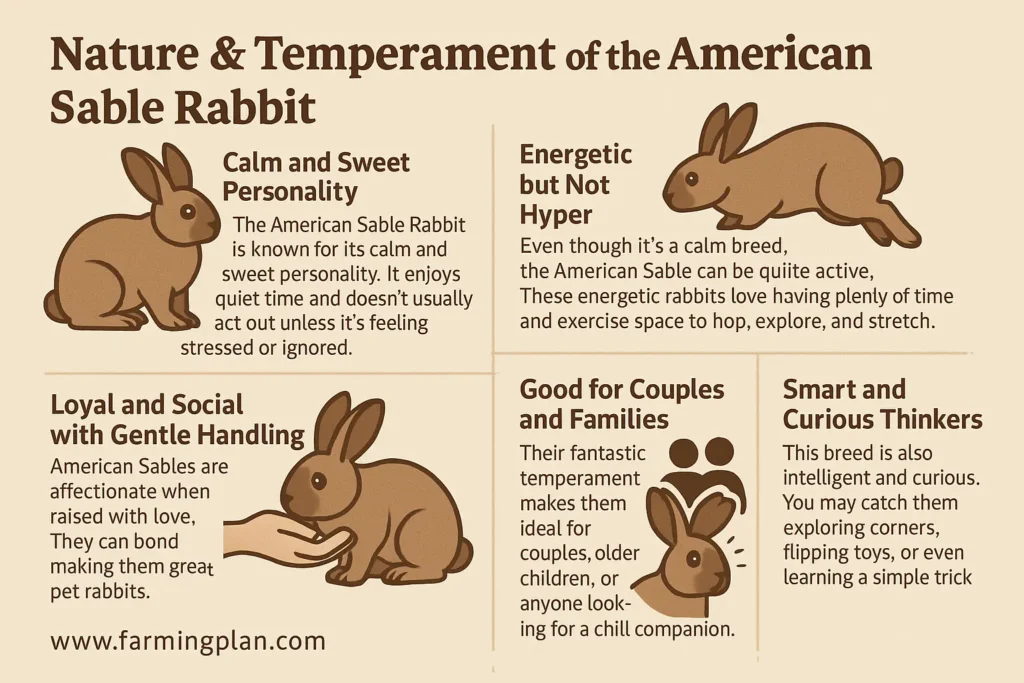This is rare breed of rabbit known as American Sable, which is prized for its fine coat and placid nature, which together combine to have an irresistible attraction. Speaking of other rabbits, with a distinctive sepia coat, and of medium build, it catches attention. American Sables are extroverts, sensitive to individuality, fond of solitude, and calm tranquility. Whether you’re a first-time pet owner or a seasoned rabbit lover, this breed is easy to care for, fun to play with, and makes a fantastic furry friend. In this guide, you’ll discover everything about the American Sable—from its origin and features to feeding tips, care routines, and where to find one.

History & Origin of the American Sable Rabbit
The American Sable Rabbit began its journey in the early 20th century in California. Otto Brock, a breeder working with Chinchilla rabbits, noticed a few kits with unusual, dark sepia coloring. Instead of removing these from his breeding line, he decided to develop them into a new, distinctive breed.
Official Recognition and Growth
This new breed, known for its smooth coat and elegant body type, gained attention. In 1929, the American Rabbit Breeders Association (ARBA) officially recognized the Sable rabbit breed. This was a big step for a rabbit that began as a simple genetic surprise.

Influence of Other Rabbit Breeds
While the American Sable has its own identity, it shares features with other rabbit breeds like the Flemish Giant and the American rabbit. However, its commercial-sized body and siamese sable coloring give it a special place in the rabbit world.
Popularity Among Pet Owners and Hobbyists
Though not as common as European rabbits or dwarf rabbit breeds, the American Sable has remained a favorite for its calm nature and rich coat color. Many breeders, hobbyists, and show enthusiasts continue to raise this breed for both companionship and exhibitions.
Characteristics of the American Sable Rabbit
The American Sable Rabbit has a strong, compact, and commercial body type. It’s not too bulky like a Flemish Giant, but larger than a dwarf rabbit. Their well-rounded body makes them easy to handle, especially for families or first-time rabbit owners.
Read More: Silver Marten Rabbit: Farming For Beginners
Signature Sepia-Toned Coat
One of the most eye-catching features of this breed is its beautiful coat. The colored coat is often described as a rich siamese sable—a warm brown or sepia shade with darker tones on the nose, ears, feet, and tail. The coat color intensity varies slightly, giving each rabbit a unique look.

Dense, Soft Fur That’s Easy to Groom
The dense coat of the American Sable is soft and short. Unlike long-haired rabbit breeds, their fur doesn’t tangle easily. During the non-shedding season, weekly brushing with a slicker brush is enough to keep it in great condition.
Eyes and Facial Features
These rabbits have bold, dark eyes that often reflect a ruby glow under certain lighting. Combined with their broad head and short ears, their look is both gentle and expressive—making them one of the cuter rabbit breeds out there.
Differences from Other Breeds
Compared to black rabbits, grey rabbits, or even Dutch rabbits, the American Sable stands out with its rich coat tone and balanced size. They resemble the average short-haired rabbit, but their unique coloring and calm nature make them easy to love.
Nature & Temperament of the American Sable Rabbit
The American Sable Rabbit is known for its calm and sweet personality. It enjoys quiet time and doesn’t usually act out unless it’s feeling stressed or ignored. This makes the breed perfect for homes that offer a peaceful environment.

Energetic but Not Hyper
Even though it’s a calm breed, the American Sable can be quite active. These energetic rabbits love having plenty of time and exercise space to hop, explore, and stretch. It’s important to give them free-range time outside their enclosure every day.
Loyal and Social with Gentle Handling
American Sables are affectionate when raised with love. They can bond with their owners, making them great pet rabbits. However, like most breeds of rabbit, they need lots of time and personal space at first to build trust. Sudden moves or loud noises may scare them.
Good for Couples and Families
Their fantastic temperament makes them ideal for couples, older children, or anyone looking for a chill companion. A fortunate couple who enjoys relaxed evenings and caring for furry friends will love having an American Sable as a pet.
Smart and Curious Thinkers
This breed is also intelligent and curious. You may catch them exploring corners, flipping toys, or even learning a simple trick. Their destructive behavior only shows up when they’re bored or kept in a cramped space for too long.
Read More: Czech Spot Rabbit: Guide for Success
Food & Diet for the American Sable Rabbit
To keep your American Sable Rabbit healthy and active, you must feed it a balanced diet. The main part of their diet should be hay, which supports digestive health and keeps their teeth in good shape. Hay should always be fresh and available.
Fresh Leafy Greens Are Essential
Leafy greens provide essential nutrients and hydration. Good choices include romaine lettuce, cilantro, parsley, and dandelion greens. Never feed your rabbit iceberg lettuce—it lacks nutrition and may upset their stomach.
Pellets for Added Nutrition
Feed your rabbit complete rabbit food pellets daily, but only in small portions. Pellets should be high in fiber and free of added sugars. These help support the condition requirements for this breed, especially during growing periods or after illness.
Fruits Are Treats, Not Meals
You can offer small pieces of fruits like apples, bananas, or berries once or twice a week. They are sweet and fun but too much sugar can harm their digestive health. Always remove seeds or pits before feeding.
Avoid Dangerous Foods at All Costs
Some foods can cause serious health issues or even be a deadly condition for rabbits. Never feed chocolate, onions, garlic, dairy, or processed snacks. These can cause loss of appetite, bloating, or worse.
“Introduce new foods slowly and one at a time—this helps you spot any bad reactions and keeps your rabbit’s tummy happy!”
Usage & Purpose of the American Sable Rabbit
The American Sable Rabbit shines as a friendly pet rabbit. Its calm nature, moderate size, and fantastic temperament make it perfect for families, couples, or solo owners. With regular quiet time and gentle handling, it becomes a loyal, affectionate friend.
Show-Quality Sable for Exhibitions
This breed often earns top prizes in rabbit shows. Its rich sepia color, dense coat, and correct body shape meet many standards for show-quality sable. Breeders and hobbyists prize them for their unique coat coloring and steady temperament in the show ring.
Hobby Breeding and Small-Scale Farming
While not a common commercial rabbit for meat, some breeders keep American Sables for small-scale, specialty farms. Their medium-sized rabbit body and steady growth make them easier to manage than larger breeds like the Flemish Giant. They also work well for those who want to breed unique rabbit breeds for sale or conservation.
Educational and Therapy Roles
Thanks to their calm, curious nature, American Sables sometimes serve in educational programs or as therapy animals. Their gentle behavior and ability to bond quickly help them comfort children, seniors, and people in care settings.
Special Features of the American Sable Rabbit
One of the standout qualities of the American Sable Rabbit is its distinctive coat. This distinctive pattern, with sepia-brown coloration interlaced with deep markings on the ears, nose, and feet is not only rare but also quite striking. Albeit with some variation in color tint, the breed always maintains its gracefully looking shape that attracts pet owners who appreciate beauty.
Compact, Well-Balanced Body Type
This breed’s compact body is another special feature. Unlike the larger Flemish Giant or the more petite Dutch rabbit, the American Sable strikes a perfect balance. Its well-rounded body type is ideal for pet owners who want a rabbit that’s easy to handle, comfortable to hold, and adaptable to both small and larger spaces.
Minimal Grooming Needs
Despite their gorgeous, dense coat, American Sables don’t require as much maintenance as long-haired rabbit breeds. Their short hair makes them relatively low-maintenance compared to other more demanding breeds. Regular brushing, especially during shedding periods, keeps their coat looking shiny and healthy.
Great Temperament for Children
American Sables are well-known for their gentle nature, making them fantastic companions for children. Their calm and friendly personality allows them to thrive in homes with young ones, especially when given a space of their own. They enjoy the company of their family but are also content with their quiet moments.
Health Issues & Prevention for the American Sable Rabbit
Just like other rabbit breeds, American Sable Rabbit also has its health issues. Common fears are the emergence of overgrown teeth that frequently lead to digestive disorders. Due to the fact that rabbits’ teeth never cease to grow, if the teeth are not properly maintained, then the animal will have dental pain and eating problems.
Preventive Care
Regular dental checkups are essential to prevent overgrown teeth. Providing unlimited hay to chew on helps keep their teeth at a healthy length. Offering a balanced diet, including fresh leafy greens and plenty of water, will also help avoid digestive issues like GI stasis.
Parasite Control
Rabbits, including the American Sable, can suffer from common parasites like mites or fleas. It is imperative that you visit a veterinarian without delay should your pet also display itching or hair loss. Regular baths for pets and cleaning their den places could also eliminate such an infestation.
Signs of Illness to Watch For
Always monitor your American Sable for signs of illness. Loss of appetite, lethargy, and abnormal behavior should be addressed quickly. Rabbits hide pain well, so keeping an eye on their normal behavior is key to early detection of health problems.
Maintaining a Healthy Weight
Obesity can lead to a variety of health issues, including joint problems and heart conditions. Ensure your American Sable gets regular exercise and doesn’t overeat. Keep treats to a minimum, and always provide fresh hay for them to graze on.
Step-by-Step Care Guide for the American Sable Rabbit
The Step-by-Step Care Guide for the American Sable Rabbit provides essential instructions to ensure your pet stays healthy and happy. Start by setting up a spacious, quiet living area with soft bedding and a litter box. Feed your rabbit a balanced diet of hay, leafy greens, and limited pellets, and always provide fresh water.Constant grooming with particular attention on shedding periods will help keep your rabbit’s coat healthy. Give your rabbit opportunities to bay around when in free range and provide them with engaging toys. Finally it is important to maintain regular veterinary examining and position enough tranquil solitary time in the environment itself.
Step 1: Setting Up the Perfect Living Space
First, create a suitable life environment for your American Sable Rabbit to be comfortable. If possible, go for a big rabbit cage or pen if you are keeping an indoor rabbit. Ensure that the home you offer to your rabbit is large enough for the rabbit to move around comfortably. Make sure there is room for rabbits to hop and stretch, this way they can roam without constraints.
Step 2: Daily Diet and Nutrition
Ensure your American Sable is served a complete meal on a daily basis. Never let the fresh hay run out for your American Sable. This is critical for their gut function and mouth health. Add the leafy greens (Spinach, Kale or Romaine lettuce) to the hay and avoid the Iceberg lettuce as it can be hazardous to your pet.
Step 3: Regular Grooming and Maintenance
Even though the American Sable Rabbit has a short coat, regular grooming is still important. Use a slicker brush once a week to remove any loose fur and keep their coat looking its best. During shedding seasons, you may need to brush more frequently to prevent hairballs.
Step 4: Exercise and Playtime
A good exercise routine is necessary for the energetic American Sable Rabbits. Give them daily access for free roaming outside their cage. In order to occupy their minds do not hesitate to give them chew toys and tunnels to play with. Make their area hazard-free, and allow them to walk around the place!
Step 5: Routine Vet Visits and Health Checks
It’s important to schedule regular vet checkups to ensure your rabbit’s health. Visits to the vet are a regular thing to help monitor dental health, ensure checking for parasites and early identification of illness symptoms. Consult your veterinarian concerning the vaccinations necessary for your rabbit against common diseases and parasites.
Step 6: Providing Quiet Time and Personal Space
Remember, American Sables are naturally calm and reserved. They need quiet time each day to rest and feel safe. If you have children or other pets, ensure that the rabbit has a designated area where it can retreat and relax. This helps prevent stress and promotes a positive relationship between your rabbit and the household.
Expert Tips & Best Practices for the American Sable Rabbit
To keep your American Sable Rabbit entertained and prevent destructive behavior, provide a variety of chew toys. These can include untreated wood, willow balls, and cardboard tubes. Chewing helps keep their teeth healthy and offers mental stimulation, preventing boredom.
Monitor Weight and Health Regularly
An important aspect of rabbit care is monitoring their weight. Obesity can lead to numerous health problems in rabbits, including joint issues and heart problems. Weigh your American Sable regularly and ensure they are active. If you notice any changes in behavior, such as loss of appetite, consult your vet immediately.
Create a Safe Outdoor Space for Play
If possible, create a safe outdoor space for your American Sable to enjoy natural sunlight. Make sure the area is secure and free from predators. Always supervise outdoor playtime to ensure your rabbit’s safety. A hutch or fenced-in area can allow them to enjoy the outdoors without risk.
Keep Their Living Area Clean and Hygienic
A clean environment is vital to your rabbit’s well-being. Clean their litter box, bedding, and water bowl daily to reduce the risk of infection or parasites. Regular cleaning of the living space helps prevent the buildup of germs and maintains a stress-free environment.
Be Patient and Build a Bond Gradually
The American Sable Rabbit is naturally gentle but may take some time to warm up to new people. Be patient and handle them gently. Allow them to approach you when they’re ready, and avoid overwhelming them with attention or noise. Building a bond with your rabbit takes time but is well worth the effort.
FAQ
What is the lifespan of an American Sable Rabbit?
The American Sable Rabbit typically lives between 5 to 8 years, depending on factors like diet, exercise, and overall care.
How should I groom my American Sable Rabbit?
Groom your American Sable Rabbit weekly using a slicker brush. During shedding seasons, increase grooming to 1–2 times per week to prevent matting.
What is the ideal diet for an American Sable Rabbit?
Provide unlimited hay (like Timothy or orchard grass), a small portion of high-quality pellets, and fresh leafy greens daily. Avoid iceberg lettuce due to its low nutritional value.
Are American Sable Rabbits good pets for children?
Yes, American Sable Rabbits have a gentle temperament and can be excellent companions for children when handled with care and respect.
What are common health issues in American Sable Rabbits?
Common health concerns include GI stasis, dental problems, and respiratory infections. Regular vet check-ups and a proper diet can help prevent these issues.
Conclusion
The American Sable Rabbit is a medium-sized breed known for its unique sepia-toned coat and gentle temperament. Originating from California in the 20th century, this breed is recognized by the American Rabbit Breeders Association. With an average lifespan of 5 to 8 years, they require a balanced diet of hay, leafy greens, and limited pellets. Regular grooming, especially during shedding seasons, is essential to maintain their dense coat. They thrive in spacious, quiet environments and benefit from daily exercise and mental stimulation. While generally healthy, they can be prone to GI stasis and dental issues, making regular veterinary care important.
